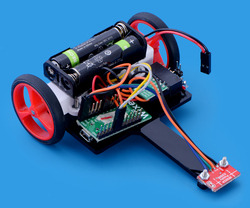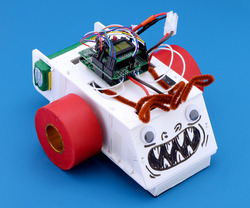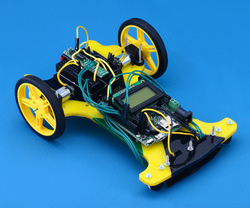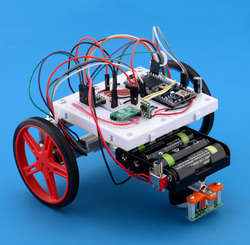Pololu Blog » Posts tagged “lvbots” »
Posts tagged “lvbots” (Page 2)
You are currently viewing a selection of posts from the Pololu Blog. You can also view all the posts.
Popular tags: community projects new products raspberry pi arduino more…
Paul's Wixel-based line following robot: Two Point Four
Two Point Four was my entry in the LVBots 2015 line following competition, originally built for our 2013 contest but significantly rebuilt since then. I designed it to be simple, low-power, and lightweight, starting with its 2×AAA, 2.4 V nominal power supply, from which it gets its name. Continued…
Amanda's line following robot: Newbie
Many of the engineers and robot enthusiasts here at Pololu competed in the LVBots 2015 line following competition. (For house rules and details about how the competition was judged, see the LVBots line following rules page.) Unlike most of my peers this was my first competition at LVBots, so I thought it was fitting to name my robot “Newbie”. Newbie uses a servo to steer the front wheels, creating fluid movements in and out of turns. At least that was the plan; unfortunately, Newbie had complications. Continued…
Grant's line following robot: Pinto
My entry for the LVBots line following competition last month was a rehash of my line following robot from last year, Pinto. Unfortunately, my robot from last year robot never made it to the competition: while trying to get it to work last minute, it literally vibrated itself apart. I did not execute my ideas very well, but I still think my overall plan was not a bad one. Since I still had all the parts, I decided I wanted to revive the robot and try to follow through with my plan. Continued…
Nathan's line following robot: Suckbot
After branching off into maze solving, pushing into sumo, and finding our way through dead reckoning, we circled back and had another line following competition at LVBots. I started designing the Suckbot before the previous line following competition over a year before this one, but the design dragged on and there was no urgent push to get it finished without another competition. The robot is designed to suck itself down to the course so it can go faster. I was able to get it following lines and sucking, and I managed to post some middle-of-the-pack lap times, but there was some unexpected behavior when tuning the PID parameters just before the competition, and I think there’s quite a bit of room for improving the robot’s performance in the future. Continued…
Jeremy's line following robot: Zumo Slim
I recently competed in the LVbots line following robot challenge, where I took third place with the fourth fastest robot (due to lucky placement in the bracket). This was my second line following competition. I learned some valuable lessons from my first competition, such as bigger motors are not always good for going faster, so I focused my build on making a lightweight robot this time. Continued…
Claire's line following robot: Oddish
A few weeks ago the local robotics club, LVBots, hosted a line following competition here at Pololu, and like many of the engineers here, I built a robot, which I named Oddish, for the competition. I really only started seriously working on my robot about a week before the competition, so when I made the final decisions about what components to use I aimed for simplicity. In the last year we have come out with several A-Star microcontroller boards that include switching regulators, so I thought it would be fun and simple to make a line follower using an A-Star as the brain and its built-in 5 V regulator to power all the other components. I chose the A-Star 32U4 Mini LV for its operating voltage range and size. Continued…
Brandon's line following robot: The Chariot
For the recent LVBots line following competition, my first instinct was to try to come up with some unique alternative design for a robot that would be competitive with the traditional differential drive robots. However, I knew the winning robot from the last LVBots line following competition (Mostly Red Racer) would be returning, and it had an impressive time to beat. I also remembered spending so much time designing and assembling the hardware for my last line following robot, that I ended up not having enough time to tune the PID coefficients and get the performance I was hoping for. After brainstorming a few ideas, I ended up deciding to keep it simple and make sure I had enough time to get a robot I was happy with, which I ultimately named “The Chariot” because of its shape. The Chariot ended up winning second place in the competition, which I was very happy with. Instead of focusing this blog post on how you can make your own version of The Chariot, I will try to explain my thought process throughout the design and build process, In other words, my hope is that after reading through this post, it will be clear why I chose the parts that I did. Continued…
Jon's line following robot: Usain Volt 2.0
Like other developers and engineers here, I made a robot for the LVBots Line Following Contest. This post describes my robot, Usain Volt 2.0, and details some of what I was thinking when I designed it. If you want to know more about the competition rules and how it was judged, see the LVBots line following rules. Continued…
David's line following robot that learns the course
Several people here made robots to compete in the recent LVBots line following competition. The goal of the competition is to make an autonomous robot that follows a line on the ground as fast as possible. I made a robot called LearnBot for the competition. LearnBot is able to learn the line course on the first lap and then use that information to its advantage on the second and third laps. Continued…
Video: LVBots April 2015 line following competition
LVBots held a line following competition at Pololu on April 16th. The goal was to make an autonomous robot that does three laps of the course the fastest. Seventeen robots faced off in a head-to-head double elimination tournament. The video above shows the robots in action and the full results of the contest.
Ben’s Mostly Red Racer won the line following competition for the second time in a row with an average speed of 1.2 m/s, but the competition was more fierce this time. Brandon secured second place with The Chariot, which had an average speed of 1.17 m/s and had a best course time that was only 0.7 seconds slower than Ben’s.
There were also some fun exhibition robots. Kevin made a hovercraft named Full of Eels that was able to sometimes follow the line. Kevin and Jeremy made The Next Level, a line follower on top of a line follower.
Here are posts about some of the robots in the contest:
- Jon’s line following robot: Usain Volt 2.0
- David’s line following robot that learns the course
- Brandon’s line following robot: The Chariot
- Jeremy’s line following robot: Zumo Slim
- Nathan’s line following robot: Suckbot
- Grant’s line following robot: Pinto
- Claire’s line following robot: Oddish
- Amanda’s line following robot: Newbie
- Paul’s Wixel-based line following robot: Two Point Four
Are you in the Las Vegas area? Check out the LVBots Meetup page to get involved.





















